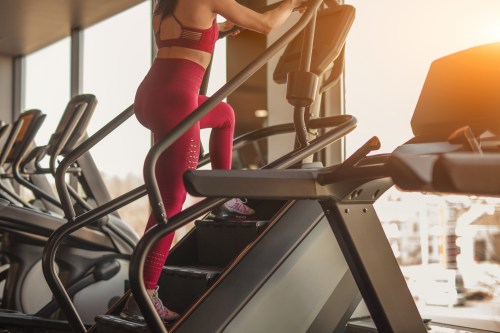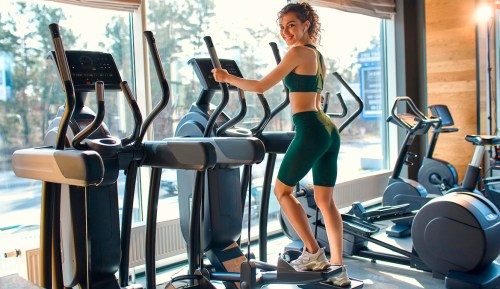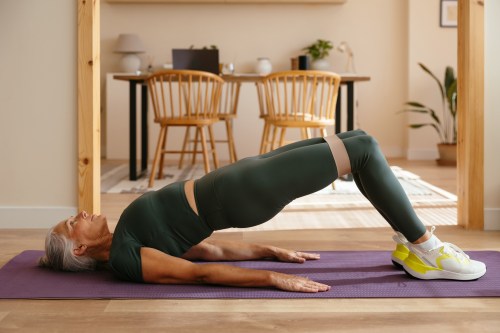If you’ve spent any time at all on TikTok lately, you’ve likely seen people posting videos of themselves doing the 10-8-4 Stairmaster workout. The viral workout, which has a collective 67.8 million posts on the social media app, is straightforward: 10 minutes on the Stairmaster at resistance level 8 for four days each week.
Experts in This Article
RRCA-certified running coach and personal trainer
personal trainer, online fitness coach, and fitness writer
Gymgoers swear by the workout as a way to flatten your stomach, slim your legs, and snatch your waist. But does it actually have a positive impact on your fitness level and health? We asked three personal trainers to weigh in on whether it's worth the hype and what to consider before strutting your stuff on the Stairmaster.
Should you try the 10-8-4 Stairmaster workout?
This viral workout comes with plenty of perks, but there are a few downsides to keep in mind when deciding if it’s right for you. Here's a breakdown of some of the pros and cons, according to fitness experts.
Benefits of the 10-8-4 workout
1. It’s customizable.
One great perk of the 10-8-4 Stairmaster workout is that you can modify it to work best for you. “It gives you just enough structure while still being completely customizable,” says Or Artzi, CPT, creator of the fitness platform Orriors. “What feels ‘hard’ is personal—and that’s the beauty of it. You’re not failing if you’re not dying on the stairs. It's all about pacing based on your current fitness level.”
To make the workout easier, Erica Coviello, CPT, a personal trainer and certified running coach, says you can lower the resistance, slow down your pace, or take breaks when you need them. For instance, you could try to do five sets of two minutes, with 30 to 60 seconds of rest between each set, adds Caroline Juster, CPT, a personal trainer and online fitness coach based in Chicago. “This would allow you to sustain a higher intensity than you could otherwise do for 10 minutes straight,” she says.
And if you want to up the ante and make the workout more challenging, you can increase pace or resistance, or you can strut while wearing a weighted vest, Coviello adds. You could also add a fifth day to your schedule or increase the length of each session, Juster says.
2. It’s great for your heart.
The climbing motion of a Stairmaster elevates your heart rate, according to Coviello, and this workout is a “great way to get in solid cardio while keeping things interesting and structured,” Artzi adds.1
Boosting your heart rate through cardiovascular exercise is important to do regularly, according to the American Heart Association (AHA). More specifically, the AHA says getting at least 150 minutes per week of moderate-intensity aerobic activity—or 75 minutes per week of vigorous aerobic activity—can lower your risk of conditions like heart disease, stroke, dementia, type 2 diabetes, and certain cancers.
This recommendation translates to getting about 30 minutes of moderate-intensity cardio five days per week, or 15 minutes of vigorous-intensity cardio for those five days. So while the 10-8-4 Stairmaster workout isn’t quite enough to meet these goals on its own, it definitely makes a dent in your overall cardio needs.
Additionally, stair climbing increases your aerobic capacity (sometimes called VO2 max), Artzi says, which is the maximum amount of oxygen your body can use at one time during intense exercise.2
Research backs this up: A small 2025 study in Nutrition, Metabolism and Cardiovascular Diseases found that 10 minutes of stair climbing five days a week for four weeks significantly increased the VO2 maxes of young men with obesity.3 And a larger 2023 review of adult men and women in the Journal of Taibah University Medical Sciences yielded similar results after four to eight weeks of stair climbing.4
3. It strengthens your bones and muscles.
Stair climbing is a weight-bearing exercise, which means it may help slow bone loss and improve bone density, according to Artzi. When you climb the stairs, your muscles push and pull against the bones of your lower body, helping them gradually increase in size. This motion may also help slow bone loss that naturally occurs with aging (a condition called osteopenia). Studies even show that stair climbing can help maintain and reduce further bone loss in older adults.5
Another benefit of the 10-8-4 workout? Artzi says it strengthens muscles in your core and lower body like your glutes, hamstrings, quads, and calves. Not only is this great for your personal fitness goals, but the strength comes in handy for everyday life tasks, too, like bending down to pick up a laundry basket, sitting and getting up from a chair, and of course, being able to go up and down the stairs in your own home.
4. It’s low-impact.
According to Artzi, the 10-8-4 workout is also considered a low-impact workout, which means it doesn’t put a ton of stress on your joints. These types of sweat sessions tend to be more accessible, lead to fewer injuries, have quicker muscle recovery times, and can be done more often than higher-impact workouts that involve lots of pounding and jumping.6,7
Drawbacks to the 10-8-4 workout
1. It might not be enough exercise for you.
While the 10-8-4 Stairmaster workout can be a stand-alone sweat sesh once in a while if you're short on time or want a quick, intense cardio burn, you’ll fall short of the AHA’s recommended physical activity guidelines if it’s all you’re doing, Coviello says.
“Forty minutes of cardio per week is a great start—especially if you're not currently exercising—but try to perform additional cardio workouts throughout the week to get the most out of your training,” Juster adds. Artzi agrees: “Don’t make it the only thing you do. A well-rounded routine should include strength, mobility, and cardio across all planes of motion. This is what keeps you balanced and strong in the long run.”
Depending on your current fitness level, the 10-8-4 workout is best done in conjunction with a strength workout, Juster explains. “Do the Stairmaster first if improving your cardio is a bigger priority, and do it after lifting if your main priority is getting stronger or building muscle,” she says.
Also, “note that when pairing workouts, you may need to go slower on the Stairmaster or adjust the intensity of the rest of your workout depending on your fitness level,” Juster adds.
2. It may lead to pain and injury if your form is off.
If you don't have the best biomechanics (aka form), you can end up doing more harm than good with this workout, Coviello cautions. “For example, if you're not engaging your glutes, you could end up with some knee pain. Or if you use the ball of your foot instead of your entire foot when you step, it might result in Achilles tenderness or ankle or calf pain,” she says.
If you're unsure whether you're using the proper form while on the Stairmaster, try looking up some tutorial videos online or enlisting the help of a personal trainer who can offer tips.
3. It can get boring.
If you’re someone who needs constant stimulation and variety in your workouts, you might find that doing the same slow, repetitive motion for 10 minutes straight is a bit dull, Coviello says. That being said, you can make the 10-8-4 workout more entertaining by listening to your favorite podcast or pump-up playlist, watching TV, or playing a mind game, like counting how many people in yellow shirts you see at the gym.
What to consider before trying this workout
Before trying out this trendy workout routine, there are a few things to keep in mind. For one, the 10-8-4 workout is likely best for someone who already has a cardio fitness routine and experience using the Stairmaster, Juster says. “For example, if you're already doing 40 minutes or more of weekly cardio or hitting the Stairmaster a few times a week, you would likely have success with this protocol,” she adds.
It's also important to consider whether you can walk comfortably for more than 10 minutes at a time, Juster says. "If you struggle to walk up a flight of stairs without getting really winded, you may want to first build fitness with easier forms of cardio," like inclined treadmill walking or walking outside.
Plus, if you have injuries (especially in your knees or lower back), this workout might not be the best option for you, Artzi says. This is because the motion of climbing stairs can put unwanted pressure and strain on those areas. “Although the Stairmaster is lower impact than some other forms of cardio, it may not be recommended if you're dealing with lower body pain or injuries,” Juster adds.
Proper form is another important factor to pay attention to while on the Stairmaster. “When executing repetitive motion, proper form—from posture to knee alignment—is incredibly important, as it promotes healthy development and overall longevity,” Artzi says.
Lastly, if this workout doesn't feel right for your body, consider asking an expert (like a physical therapist or personal trainer) to help you learn how your body functions most efficiently and pain-free. They can suggest other kinds of workouts that are better suited for you.
Juster agrees: It's always important to consider your health and base fitness levels before starting a new workout. “Get clearance from your doctor first if you're not sure if this type of training is appropriate for you,” she adds.
The bottom line
All in all, the 10-8-4 Stairmaster workout is a fun, low-impact way to help boost heart health and strengthen your bones and muscles. It's a great option for people with beginner-level experience using stairclimbers or doing cardio since it can be modified to meet your personal goals.
That said, if you're more advanced in your fitness journey, the 10-8-4 workout might not be enough exercise for you (it doesn't meet the U.S. daily physical activity guidelines), so you may want to try it alongside other workouts—like a strength training circuit or weightlifting session. Also, if you're not paying attention to proper stair climbing form, you may end up with aches, pains, or an injury if you're not careful.
And despite what you may see online, there’s no special magic to this workout. “I see a lot of people saying this workout will snatch your waist,” Juster says. “Cardio has tons of benefits, but it won't necessarily change the shape or size of your body without accompanying changes to your nutrition. That doesn't mean you shouldn't do it—regular cardio is one of the best things you can do for your health, energy levels, and performance.”
Yes, you can reap these benefits from other cardio workouts, but you may have more success sticking with the 10-8-4 workout if you enjoy the Stairmaster or don't have access to other cardio equipment, Juster says.
- Ghosal, Anang M, and Baskaran Chandrasekaran. “Stair-climbing interventions on cardio-metabolic outcomes in adults: A scoping review.” Journal of Taibah University Medical Sciences vol. 19,1 136-150. 1 Nov. 2023, doi:10.1016/j.jtumed.2023.10.003 ↩︎
- “Aerobic Capacity.” Aerobic Capacity - an Overview | ScienceDirect Topics, www.sciencedirect.com/topics/nursing-and-health-professions/aerobic-capacity. Accessed 10 Apr. 2025.
↩︎
Han, Minsub et al. “Effect of brief intense stair climbing on cardiorespiratory fitness and metabolic risk factors in inactive young men with obesity: A randomized controlled trial.” Nutrition, metabolism, and cardiovascular diseases : NMCD, 103902. 6 Feb. 2025, doi:10.1016/j.numecd.2025.103902 ↩︎- Ghosal, Anang M, and Baskaran Chandrasekaran. “Stair-climbing interventions on cardio-metabolic outcomes in adults: A scoping review.” Journal of Taibah University Medical Sciences vol. 19,1 136-150. 1 Nov. 2023, doi:10.1016/j.jtumed.2023.10.003 ↩︎
- Dostan, Ali et al. “Relationship between stair ascent gait speed, bone density and gait characteristics of postmenopausal women.” PloS one vol. 18,3 e0283333. 22 Mar. 2023, doi:10.1371/journal.pone.0283333
↩︎ - Tse, Andy C Y et al. “Effect of Low-intensity Exercise on Physical and Cognitive Health in Older Adults: a Systematic Review.” Sports medicine - open vol. 1,1 (2015): 37. doi:10.1186/s40798-015-0034-8 ↩︎
- Lee, Doowon et al. “Effects of Individualized Low-Intensity Exercise and Its Duration on Recovery Ability in Adults.” Healthcare (Basel, Switzerland) vol. 9,3 249. 1 Mar. 2021, doi:10.3390/healthcare9030249 ↩︎
Sign Up for Our Daily Newsletter
Get all the latest in wellness, trends, food, fitness, beauty, and more delivered right to your inbox.
Got it, you've been added to our email list.











